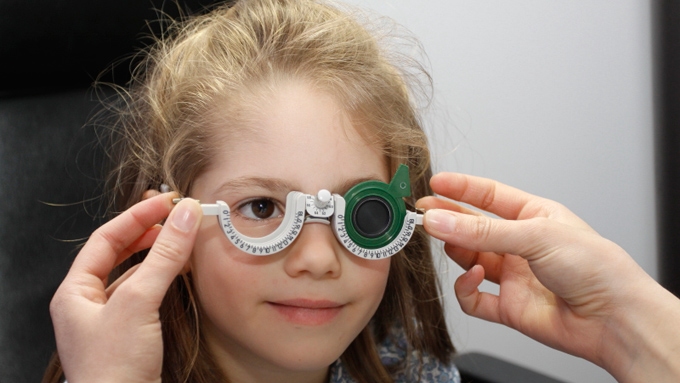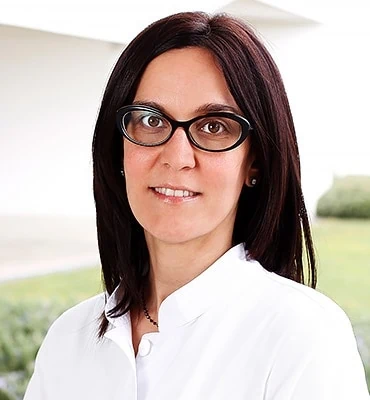
What is "lazy eye"?
“Lazy eye”, or amblyopia, is caused by low vision in one or both eyes due to lack of use during a child’s visual development (approx. before the age of eight). It is a disorder that originates in childhood, but can continue into adulthood, if it is not diagnosed and treated early.
What causes it?
The main causes are:
- Strabismus: when the eyes are misaligned and point in different directions, the child’s brain, which has a great ability to adapt, suppresses vision in one eye to counter the abnormality and prevent double vision.
- Refractive error: when a child has hyperopia, astigmatism or myopia, the image that reaches the brain lacks sharpness, resulting in the brain selecting the vision of the eye with less refractive error.
- Cataracts, ptosis (drooping eyelid), retinal diseases: other diseases that interfere with the proper development of vision in children.
How can it be prevented?
All children should undergo an ophthalmic examination to detect for amblyopia before the age of three. Early diagnosis is vital to ensure that “lazy eye” is treated properly and to prevent the condition from continuing into adulthood.
A paediatric ophthalmologist can perform an examination to detect for this disorder at any age, however small and uncooperative the child.
Symptoms
Parents, teachers or caregivers may suspect that the child has abnormal vision in the following types of circumstances:
- Family members cannot easily be identified over long distances.
- Objects need to be held close to the eyes.
- One eye deviates.
- In most cases, as the child can see well with the good eye, normal development occurs, with the amblyopia remaining present until a routine eye test by a paediatrician, optician or ophthalmologist detects the problem.
Treatments
Treatment involves correcting the cause of amblyopia (strabismus, refractive error, drooping eyelid, etc.) and, at the same time, forcing the lazy eye to work, at the expense of the good eye. The best and fastest way of achieving this is by patching the healthy eye over a period of time, the length of which is determined by the degree of amblyopia and the age of the child.
Other methods of penalising the healthy eye include the use of dilating eye drops to cause blurred vision or prescription glasses that are unnecessary for the good eye.
Specialists who treat this pathology
FAQs
There are several eye diseases that are linked to chromosomal inheritance and even the genetic defect is determined. Diseases of all parts of the eye can be inherited. The most common is retinitis pigmentosa.
Obviously, if there is a vision problem, at any age. During their schooling it is obligatory for all children to be examined at the age of four or five to determine their visual ability.
The amblyopic eye has not developed vision correctly, but all eye structures are in good condition. Vision develops from birth, and the eye becomes increasingly more capable of perceiving objects, which is called visual acuity. The amblyopic eye does not develop visual acuity for various reasons. The eye is anatomically correct, i.e. its structures are normal, but vision has not developed.
Ocular occlusion is used to make the diseased eye work harder by patching the healthy one, as in amblyopia. The intensity of the patching of the good eye to develop the vision of the amblyopic eye depends on the degree of vision and the age of the patient.
IMO Institute of Ocular Microsurgery
Josep María Lladó, 3
08035 Barcelona
Phone: (+34) 934 000 700
E-mail: international@imo.es
See map on Google Maps
By car
GPS navigator coordinates:
41º 24’ 38” N – 02º 07’ 29” E
Exit 7 of the Ronda de Dalt (mountain side). The clinic has a car park with more than 200 parking spaces.
By bus
Autobus H2: Rotonda de Bellesguard, parada 1540
Autobus 196: Josep Maria Lladó-Bellesguard, parada 3191
Autobuses H2, 123, 196: Ronda de Dalt – Bellesguard, parada 0071
How to arrive at IMO from:
IMO Madrid
C/ Valle de Pinares Llanos, 3
28035 Madrid
Phone: (+34) 910 783 783
See map in Google Maps
Public transport
Metro Lacoma (líne 7)
Autobuses:
- Lines 49 & 64, stop “Senda del Infante”
- Line N21, stop “Metro Lacoma”
Timetables
Patient care:
Monday to Friday, 8 a.m. to 9 p.m.
IMO Andorra
Av. de les Nacions Unides, 17
AD700 Escaldes-Engordany, Andorra
Phone: (+376) 688 55 44
See map in Google Maps
IMO Manresa
C/ Carrasco i Formiguera, 33 (Baixos)
08242 – Manresa
Tel: (+34) 938 749 160
See map in Google Maps
Public transport
FGC. Line R5 & R50 direction Manresa. Station/Stop: Baixador de Manresa
Timetables
Monday to Friday, 09:00 A.M – 07:00 PM








